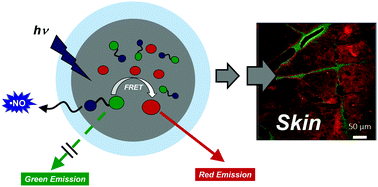Monitoring the release of a NO photodonor from polymer nanoparticles via Förster resonance energy transfer and two-photon fluorescence imaging†
Abstract
Core–shell polymeric nanoparticles (NPs) made of either di-block or tri-block poly-ε-caprolactone and polyethylene glycol copolymers, covalently integrating Rhodamine B in the core or the shell have been prepared and a green fluorescent NO photodonor entrapped therein. One- and two-photon fluorescence experiments demonstrate that effective Förster Resonance Energy Transfer (FRET) occurs exclusively in the di-block NPs having the Rhodamine in the core, accounting for a localization of the NO photoreleaser in the inner part of the polymeric nanocarrier. These di-block NPs are stable in the presence of human serum albumin and their cargo release NO under exclusive excitation with visible light. Two-photon imaging experiments carried out using 900 nm NIR light, demonstrate that the release of the NO photodonor can be monitored in biological tissue, herein human skin, and provide insights into the integrity and penetration depth of the NPs. Toxicity experiments performed on NCTC keratinocyte cell lines in the dark and upon visible light irradiation show good biocompatibility of the polymeric system that therefore has a great potential in light of the multifaceted therapeutic role of NO.



 Please wait while we load your content...
Please wait while we load your content...